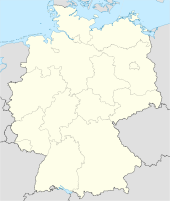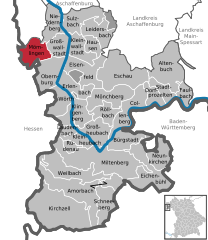- Mömlingen
-
Mömlingen 
Coordinates 49°51′N 9°5′E / 49.85°N 9.08333°ECoordinates: 49°51′N 9°5′E / 49.85°N 9.08333°E Administration Country Germany State Bavaria Admin. region Lower Franconia District Miltenberg Mayor Siegfried Scholtka (CSU) Governing party CSU Basic statistics Area 18.45 km2 (7.12 sq mi) Elevation 148 m (486 ft) Population 4,929 (31 December 2010)[1] - Density 267 /km2 (692 /sq mi) Other information Time zone CET/CEST (UTC+1/+2) Licence plate MIL Postal code 63853 Area code 06022 Website www.moemlingen.de Mömlingen is a municipality in the Miltenberg district in the Regierungsbezirk of Lower Franconia (Unterfranken) in Bavaria, Germany.
Contents
Geography
Location
Mömlingen, which styles itself “Gateway to the Odenwald”, lies framed by wooded heights of the northern Odenwald on the Bavaria-Hesse boundary in the charming Mümling valley. Bordering on Mömlingen are the Bavarian district of Aschaffenburg in the north, and in the west the two Hessian districts of Darmstadt-Dieburg and Odenwaldkreis.
History
Celts and Romans
Witnessing a prehistoric human presence are many barrows and sporadic finds, some of which go back to the Stone Age. From Roman times come parts of so-called Jupiter Columns (or Jupitergigantensäulen in German) and other worship stones. They show, together with the many traces of Roman country houses (villae rusticae) in the heights all around Mömlingen, the extent of the once mighty Roman Empire, which only a few kilometres away to the east held its frontier at the “Wet Limes”, namely the Main.
Frankish settlement
An early Frankish settlement beginning in the 6th century in what is now the heart of the community is witnessed by an extensive row grave field unearthed by archaeologists west of the village. Besides the many graves with scanty or missing grave goods, graves with extraordinarily rich appointments were discovered, such as a Mainz gold coin and remnants of silk, leading to the conclusion that there was a stately noble class among the villagers. These nobles could well have driven the Frankish taking of the land on royal orders.
First documentary mention
The settlement itself crops up in written records as Miminingen in a document from the Imperial Abbey at Fulda issued sometime between 802 and 817 (Abbot Ratgar’s time in office). Compared to many neighbouring communities, this is a very early first documentary mention.
To early Frankish times can be dated the establishment of the first church in Mömlingen. Bearing witness to this is what is said to be the typically Frankish custom of consecrating the old parish church to Saint Martin of Tours.
Church and nobility – Mainz and Breuberg
From the Middle Ages, many ecclesiastical institutions and members of the upper and middle nobility are known who had holdings in the municipal area, imposed taxes and held sundry rights. In 1024, Emperor Heinrich II donated the County of Stockstadt, within which lay Mömlingen, to the Imperial Abbey at Fulda. In 1278, the place passed with the County of Bachgau to Electoral Mainz. The circumstances of Mömlingen’s belonging politically (until 1803) to the Electoral Mainz tithing region of the Bachgau while village jurisdiction, extensive landholdings and further traditional entitlements were held by the lords at the nearby Breuberg Castle led to neverending disputes between the territorial overlords of Mainz and Breuberg.
Lords of Mimling – Hans Memling
In the Late Middle Ages, members of a, probably, lower noble family named “von Mimling” (among other spellings) began cropping up in documents, mostly as clergymen and tithe counts. Historical research leaves no doubt that the forebears of the famous painter Hans Memling, born about 1435 in Seligenstadt, came from Mömlingen. His works can now be found hanging in the world’s most famous painting galleries.
Hausen hinter der Sonne
South of Mömlingen, on the north slope of the Buchberg, once stood the village of Hausen hinter der Sonne (the affix meaning “Behind the Sun”), belonging to the Bishopric of Bamberg. The great countrywide wave of Plague that swept across the land in 1348 may already have thoroughly decimated the inhabitants, but the little settlement finally died in the early 16th century when the last few inhabitants moved to Mömlingen, likely under the effects of war. Mömlingen’s municipal area thereby grew considerably. Even neighbouring Hainstadt gained land area by the small village’s death.
Thirty Years’ War and its aftermath
Information about Mömlingen’s size in the Late Middle Ages can be drawn from an interest register from 1426. At this time, the Counts of Wertheim, as holders of the lordship of Breuberg, were taxing 62 farms. Hence, Mömlingen was quite a grand place. Grave effects on Mömlingen’s development were brought by the Thirty Years' War (1618–1648). Plague, sacking and pillaging harried the people, leaving only a few survivors by 1650. Many longtime families had been taken away by this dreadful war. Soon after the war ended, many new names come forth from the archives. Newcomers arrived mainly from the South Tyrol, France and the Netherlands.
The Thirty Years’ War also thwarted the building of a new local church. Only in 1774-1777 could the plan be realized. The old parish church built in the Baroque style is said to be the community’s landmark.
Mömlingen passes to Bavaria
With the onset of the 19th century, an epoch that had lasted more than 600 years came to an end when Mömlingen ceased to be part of Electoral Mainz’s once vast holdings. In 1803 it passed to the newly formed Principality of Aschaffenburg, with which it passed in 1814 (by 1810 it had become a department of the Grand Duchy of Frankfurt) to Bavaria.
Today the community of Mömlingen, which since the Second World War has undergone great growth through building, presents itself as a lower centre that has at its disposal a colourful pallet of not-for-profit institutions, and whose scenically charming location is treasured by many visitors.
Politics
Community council
The council is made up of 20 council members, not counting the mayor, with seats apportioned thus:
(as at municipal election held on 2 March 2008)
Town partnerships
 La Rochette, Savoie, France since 1992
La Rochette, Savoie, France since 1992
Coat of arms
The community’s arms might be described thus: Gules, a wheel spoked of six argent between in chief three roses of the second seeded Or in bar arched, in base two mullets of six of the second.
Although the example in this article does not show it clearly, the German blazon clearly states that the roses are to be “seeded Or”, that is, with golden centres (“Rosen mit goldenen Butzen”).
The six-spoked wheel, the so-called Wheel of Mainz, comes from the arms borne by the Archbishopric of Mainz, to which the community belonged until the Old Empire’s downfall in 1803. The heraldic roses are drawn from the arms once borne by the Counts of Wertheim, and the mullets (star-shapes) are from those once borne by the Schenken (roughly, “stewards” or “bearers”) of Erbach.
The arms have been borne since 1955[2].
Culture and sightseeing
Buildings
- The old parish church, St. Martin, a Baroque church, built in the years 1774 to 1777
Further reading
- Adam Otto Vogel: Heimat und Ortsgeschichte Mömlingen. Selbstverlag, 21 November 2011.
- Wolfgang Hartmann (Ed.): Mömlingen – wie’s einmal war. Ein Bildband mit historischen Fotografien und Geschichten von Mömlingen aus dem Zeitraum 1871–1951
- Wolfgang Hartmann (Ed.): Mömlingen – im Wandel der Zeit. Ein Bildband mit historischen Fotografien und Geschichten von Mömlingen aus dem Zeitraum 1952–1977
- Karl Bolz, Wolfgang Hartmann (ed.): Mömlingen im 20. Jahrhundert.
References
- ^ "Fortschreibung des Bevölkerungsstandes" (in German). Bayerisches Landesamt für Statistik und Datenverarbeitung. 31 December 2010. https://www.statistikdaten.bayern.de/genesis/online?language=de&sequenz=tabelleErgebnis&selectionname=12411-009r&sachmerkmal=QUASTI&sachschluessel=SQUART04&startjahr=2010&endjahr=2010.
- ^ Description and explanation of Mömlingen’s arms
External links
- Mömlingen history portal (German)
- Community’s official webpage (German)
- This article incorporates information from the German Wikipedia.
Altenbuch | Amorbach | Bürgstadt | Collenberg | Dorfprozelten | Eichenbühl | Elsenfeld | Erlenbach am Main | Eschau | Faulbach | Großheubach | Großwallstadt | Hausen | Kirchzell | Kleinheubach | Kleinwallstadt | Klingenberg am Main | Laudenbach | Leidersbach | Miltenberg | Mömlingen | Mönchberg | Neunkirchen | Niedernberg | Obernburg | Röllbach | Rüdenau | Schneeberg | Stadtprozelten | Sulzbach am Main | Weilbach | Wörth am MainCategories:- Municipalities in Bavaria
- Miltenberg district
Wikimedia Foundation. 2010.


